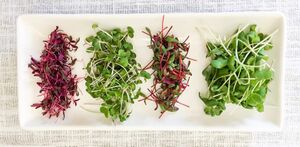Microgreens
Microgreens are tiny, edible herbaceous growth from the seeds harvested shortly after germination and are frequently consumed in salads, in sandwiches, and as garnishments. They're smaller than baby greens and larger than sprouts. Microgreens grow in soil or substrate, require natural or artificial sunlight for growth, and are harvested when they are 7 to 14 days old and 1 to 3 inches tall. Their flavor is much more intense than that of mature greens.[1]
Variaities
| Family | Name | Notes |
|---|---|---|
| Amarenth family | Beet greens | Sweet and earthy with slighly smoky undertones[2] |
| Amarenth family | Magenta spreen | Mild flavor smiliar to spinach[2] |
| Amarenth family | Rainbow chard | Citrus and slightly salty flavors, tangy with a crunchy texture[2] |
| Amarenth family | Ruby red orach | Earthy flavor that is similiar to spinach[2] |
| Parsley family | Carrot | Earthy flavor with notes of pine, celery, and parsley. Tastes like carrot root[2] |
| Parsley family | Celery | Slightly salty and watery, mild flavors. Slightly sweet undertones.[2] |
| Parsley family | Cilantro | Floral and fragrant with warm, toasted coriander undertones[2] |
| Parsley family | Fennel | Very floral and cool. Strong herby licorice flavor[2] |
| Mint family | Genovese basil | Strongest basil smell, mild flavor, slightly grassy and green. Slightly astringent, with a sensation of spice/tingling on the tongue.[2] |
| Mint family | Holy basil | Grassy, licorice and lime flavor, with a numbing cool stringency closer to Thai basil than the Italian basil varietals[2] |
| Mint family | Rosie basil | Light licorice flavor with grassy notes, initial bite of flavor up front with a warm aftertaste. Slightly astringent on the tongue.[2] |
| Mint family | Thai basil | Very fragrant with pronounced licorice flavor with strong notes of anise. Numbing anesthetic feeling on the tongue.[2] |
| Mint family | Lemon balm | Floral and tropical perfume. Citrus flavor with spice and mint undertones.[2] |
| Mint family | Red shiso | Strong cumin flavor with cinnamon notes. Slightly mineral aftertaste and mouthfeel.[2] |
| Basellaceae family | Red malabar spinach | Grassy, musty, and vegetal flavors; tannic and slightly slimy mouthfeel.[2] |
| Mustard family | Argula | Very peppery with citrus undertones; bold and pungent.[2] |
| Mustard family | Bok choy | Strong lettuce flavor with cabbage undertones.[2] |
| Mustard family | Broccoli | Mild broccoli flavor; cabbage undertones.[2] |
| Mustard family | Collard greens | Mild kale flavor with slightly bitter spinach undertones.[2] |
| Mustard family | Daikon radish | Sharp, spicy, cruciferous.[2] |
| Mustard family | Kale | Nutty with coffee undertones; warm.[2] |
| Mustard family | Purple radish | Cruciferous, sharp, and spicy, but milder than daikon radish microgreens.[2] |
| Mustard family | Red mustard | Very strong horesradish flavor, sharp and peppery.[2] |
| Aster family | Dandelion | Earthy and bitter with a sour and tannic aftertaste.[2] |
| Aster family | Sunflower shoots | Sweet and nutty with caramel notes; soft and warm.[2] |
| Legume family | Chickpea | Floury and nutty with a crisp flavor.[2] |
| Legume family | Pea tendril | Grassy notes up front with a vegetal finish.[2] |
| Buckwheat family | Green sorrel | Mild flavor with a lemony tang.[2] |
| Buckwheat family | Red-veined sorrel | Very bitter, with a strong up front minerality that dissipates quickly; clean, astringment finish; short burst of flavor that is not long lasting.[2] |
| Purslane family | Purslane | Earthy, sour, salty, and wet.[2] |
| Nasturtium family | Nasturtium | Sweet up front with a sharp sting and peppery finish.[2] |
Production
Polypropylene 1020 trays are often used when growing microgreens in production. Pre-cut grow pads are the easiest to use initially but require more frequent watering than soil methods, are more expensive, unable to grow certain varieties, less flavorful, shorter shelf life, have lower yields, and are not reusable.[3]
Place 2 cups of water in a 1020 tray (without holes)[4] and fill with sifted unmoistened organic soil[5][6] leaving about ½-¼" of space from the top of the soil to the lip of the tray.[7]. Press soil down with a flat board.
Spread 1½oz of small organic seeds evenly on top of the soil paying attention to avoid clumps and pockets of seeds.[8][9] Lightly mist the seeds with water.[10]
Stack four trays and place an empty tray (without holes) on top.[11] Place a concrete paver on top of the stack and place in a dark warm room.[12]
Harvest after about 10 days.[13] Position the tray at a steep angle over a clean container and use a handheld hedge trimmer.[14] If selling commercially in the United States, do not wash or process the greens and instead pack the microgreens in a container that directs buyers to wash them before using to avoid additional government regulations.[15]
Compost the soil and reuse the tray. Sanitize the tray with 6 parts water and 4 parts hydrogen peroxide (3% solution stored in light-proof containers)).[16]
Consider using shallow 1020 trays to reduce soil usage while exposing more of the microgreens for harvesting. The shallow trays might be able to be sanatized in a dishwasher.
References
- ↑ https://www.drweil.com/diet-nutrition/nutrition/what-are-microgreens/
- ↑ 2.00 2.01 2.02 2.03 2.04 2.05 2.06 2.07 2.08 2.09 2.10 2.11 2.12 2.13 2.14 2.15 2.16 2.17 2.18 2.19 2.20 2.21 2.22 2.23 2.24 2.25 2.26 2.27 2.28 2.29 2.30 Davison, Brendan. The Microgreens Cookbook. Rizzoli International Publications, 2017. p 43-45.
- ↑ https://www.youtube.com/watch?v=zpzIrrhFyeo
- ↑ https://youtu.be/dtvuMNVLISo?t=184
- ↑ https://youtu.be/4TpbLG_DR4o?t=126
- ↑ https://youtu.be/xgAC2sZPOKY?t=1434
- ↑ https://youtu.be/dtvuMNVLISo?t=241
- ↑ https://youtu.be/dtvuMNVLISo?t=317
- ↑ https://youtu.be/xgAC2sZPOKY?t=1434
- ↑ https://youtu.be/dtvuMNVLISo?t=388
- ↑ https://youtu.be/xgAC2sZPOKY?t=1204
- ↑ https://youtu.be/xgAC2sZPOKY?t=1204
- ↑ https://youtu.be/xgAC2sZPOKY?t=1650
- ↑ https://www.youtube.com/watch?v=k6ed6YY6wV8
- ↑ https://youtu.be/xgAC2sZPOKY?t=1663
- ↑ https://youtu.be/xgAC2sZPOKY?t=1879
